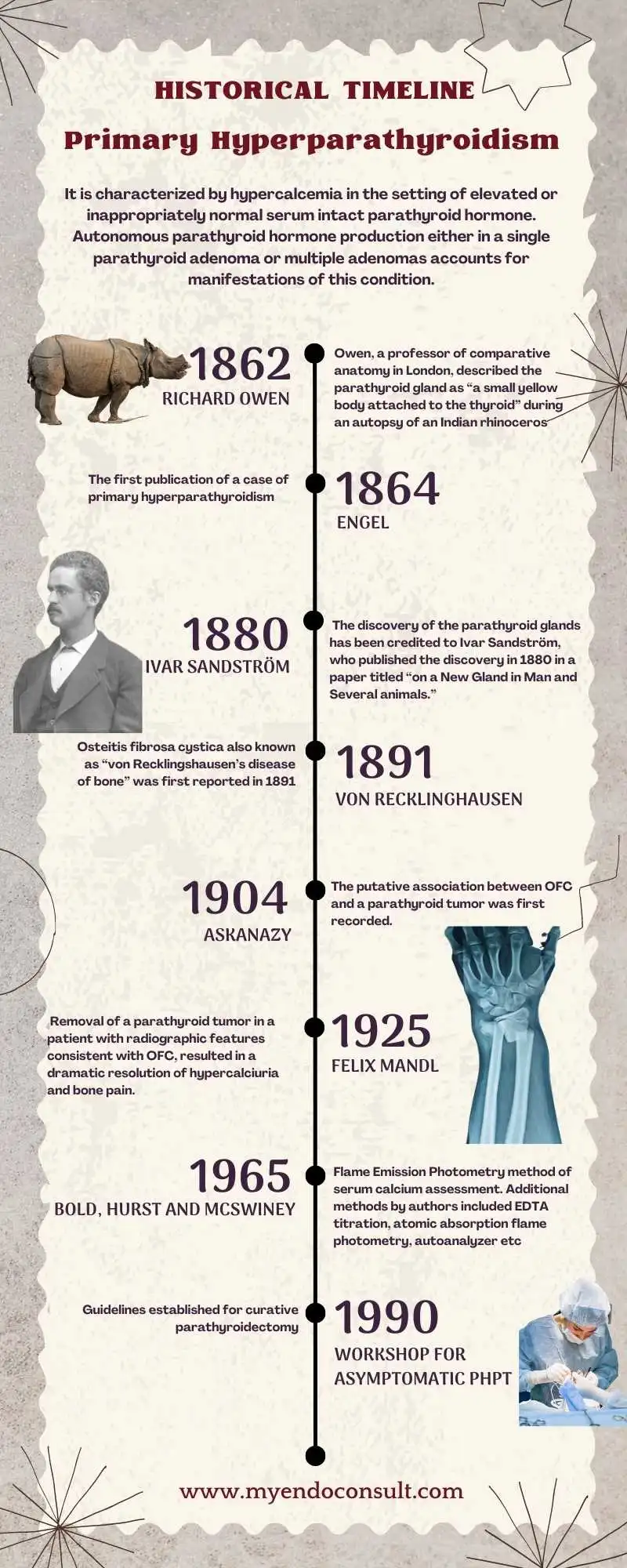
Primary hyperparathyroidism (PHPT) is a metabolic bone disease characterized
by hypercalcemia, hypophosphatemia, and inappropriately elevated PTH
due to autonomous production of parathyroid hormone by a parathyroid adenoma, hyperplasia or rarely, carcinoma.
The parathyroid glands were first discovered by Richard Owen in 1852 when he performed an autopsy on the Great Indian Rhinoceros kept by the Zoological Society of London. Owen, a professor of comparative anatomy in London, described the parathyroid gland as “a small yellow body attached to the thyroid” during an autopsy of the rhinoceros. However, the discovery of the parathyroid glands has been credited to Ivar Sandström, who published the discovery in 1880 in a paper titled “on a New Gland in Man and Several animals.” Due to the late anatomical description of these glands, they have often been referred to as “the last anatomic discovery.”

Phenotypes of primary hyperparathyroidism
These have been categorized into phenotypes varying from classic features of severe hyperparathyroidism characterized by target organ injury (urolithiasis and osteoporosis), through to mild biochemical and radiographic features without clinical symptoms to a disease entity with only mild elevation in serum parathyroid hormone levels.
The clinical phenotypes of primary hyperparathyroidism (PHPT) over the past 50 years.
Before 1970 : A disease of bones, stones, groans, and psychiatric moans and fatigue overtones. This is the classic symptom pentad of primary hyperparathyroidism which was seen in most patients prior to the universal assessment of serum calcium in patients seen in health care settings.
1970-2000: A disease with primarily biochemical and densitometric signatures.
After 2000: A disease that may present at first with a more subtle biochemical signature – elevated parathyroid hormone (PTH) levels with normal serum calcium.
What is the normocalcemic variant of primary hyperparathyroidism
This disease entity was recognized at the time of the Third International Workshop. Subsequently, formal diagnostic criteria and management recommendations were made at the Fourth International Workshop. Nonetheless, there is still no evidence to guide physicians regarding management decisions
Diagnostic features of normocalcemic primary hyperparathyroidism
- Persistently elevated (>3 months) PTH levels
- Normal albumin-adjusted serum calcium
- Normal ionized calcium *
*4-64% of patients with a diagnosis of normocalcemic PHPT were reclassified as having traditional hypercalcemic disease with measurement of ionized calcium based on a study by Nordensterom et al.
Secondary causes of hyperparathyroidism would need to be excluded before making a diagnosis of the normocalcemic variant of primary hyperparathyroidism.
- Vitamin D deficiency : 25-hydroxyvitamin D of <30 ng/mL (<75 nmol/L)
- Renal insufficiency (estimated GFR <60 ml per minute)
- Medications : Thiazide diuretics, lithium, bisphosphonates, denosumab, anticonvulsants, proton pump inhibitors, sodium glucose cotransporter-2 inhibitors)
- Hypercalciuria (>250mg for women or >300mg per 24hours in men)
- Insufficient dietary calcium intake or gastrointestinal malabsorption (status post gastric bypass surgery)
- Disorders of phosphate metabolism
- Hypoalbuminemia (may mask hypercalcemia, especially if this is not corrected for)
Mechanism of normocalcemic primary hyperparathyroidism
A proposed mechanism for this condition is significant target tissue resistance to PTH action. Subsequently, there is steady rise in PTH which precedes the onset of overt hypercalcemia by an unspecified period. It can therefore be seen as a forme fruste of classic PHPT.
Medical management of normocalcemic primary hyperparathyroidism
In a small randomized controlled trial by Cesareo et al the authors treated patients with normocalcemic PHPT and low bone mineral density with either alendronate or cholecalciferol. They observed a statistically significant increase in bone density in patients with normocalcemic PHPT treated with alendronate (n=15) vs cholecalciferol alone (n=15)
- +4.7% with alendronate at the lumbar spine vs -1.6% with cholecalciferol
- +4.0% with alendronate increase at the total hip vs -1.4% with cholecalciferol
In a small unblinded pilot study of 6 patients with normocalcemic PHPT using cinacalcet at a dose sufficient to decrease PTH levels, the authors reported a low number and diameter of kidney stones. The significance of this finding would need to be tested in future studies.
Surgical management of normocalcemic primary hyperparathyroidism
There is limited data to show normocalcemic patients after surgery have improvement in bone density, nephrolithiasis, cardiovascular parameters, and quality of life.
| Study | Monitoring | Surgical Management |
|---|---|---|
| Tordjman et al.(2004) | 20 patients followed for 4.1 ± 3 years without developing hypercalcemia | 12 patients with positive localization underwent PTX; single adenoma or hyperplasia |
| Lowe et al.(2007) | 40% of patients developed other signs of PHPT (3.1 ± 2 years), 19% with hypercalcemia | 3 hypercalcemic and 4 normocalcemic patients underwent PTX; single adenoma or hyperplasia |
| Šiprová et al.(2016) | 111 patients followed for at least 4 years with 19% becoming hypercalcemic (67% within 2 years) | 9 hypercalcemic patients underwent PTX, 8 with adenoma were cured |
How do you evaluate normocalcemic primary hyperparathyroidism?
Monitor serum total and ionized calcium and exclude secondary causes of hyperparathyroidism (vitamin D deficiency, renal failure, drugs, malabsorption, hypercalciuria, disorders of phosphate metabolism)
What medical therapy can be offered for patients?
- Antiresorptive therapy for osteoporosis.
- Consider cinacalcet for kidney stones
Who should we refer for parathyroid surgery?
Patients with a clearly established diagnosis with a long-standing history of elevated PTH values, symptoms, and a clear target on localization studies
References
- Nordenström E, et al. Clin Biochem. 2011;44:849-52
- Cesareo R, Di Stasio E et al. Effects of alendronate and vitamin D in patients with normocalcemic primary hyperparathyroidism. Osteoporos Int. 2015 Apr;26(4):1295-302.
- Zavatta G, Clarke BL. Normocalcemic Primary Hyperparathyroidism: Need for a Standardized Clinical Approach. Endocrinol Metab (Seoul). 2021 Jun;36(3):525-535.
Kindly Let Us Know If This Was helpful? Thank You!


